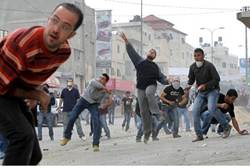Note to New York Times: Throwing Stones is an Act of Violence
August 5, 2013 15:06
by Alex Margolin

New York Times reporter Jodi Rudoren is the latest apologist to present Palestinian stone throwers as noble defenders of their land and victims of Israeli oppression rather than as violent criminals:
Here in Beit Ommar, a village of 17,000 between Bethlehem and Hebron that is surrounded by Jewish settlements, rock throwing is a rite of passage and an honored act of defiance. The futility of stones bouncing off armored vehicles matters little: confrontation is what counts.
Rudoren focuses much of the story on a 17-year old Palestinian youth who has been arrested four times “for throwing stones at Israeli soldiers and settlers” – not civilians but settlers. Apparently do not merit the standard rights of civilians in Rudoren’s worldview simply because of where they choose to live. At the same time, Rudoren goes to great lengths to build sympathy for the Palestinian youth and his family, noting how his mother made sure to give him a long sleeve shirt for his stay in prison because “they both knew it would be cold in the interrogation room.”
The “settlers” don’t receive nearly the same level of empathy, even when they are the victims of the rocks being thrown. Menuha Shvat, the only Gush Etzion resident quoted in the story, is also the only one who discusses how dangerous rock throwing can be.
“It’s crazy: I’m going to get pizza, and I’m driving through a war zone,” said Ms. Shvat, who knew a man and his 1-year-old son who died when their car flipped in 2011 after being pelted with stones on Road 60. “It’s a game that can kill.”
Although we learn about the cold of the interrogation room and other details of the lives of the Palestinians in the story, Rudoren does not even bother to name the Israeli victims she mentions. In fact, the man’s name is Asher Palmer, and his one-year old son is Yonatan. And they didn’t simply die. They were killed, and the Palestinians who threw the rocks were convicted of murder.
The Palestinians Rudoren interviews never question the moral aspect of throwing stones, and neither does Rudoren. She has a matter-of-fact explanation for why they do it:
They throw because there is little else to do in Beit Ommar — no pool or cinema, no music lessons after school, no part-time jobs other than peddling produce along the road. They do it because their brothers and fathers did.
So long as the victims continue to be “soldiers and settlers,” it might not make much difference to Rudoren.
Rudoren’s piece follows on the heels of an article by Amira Hass in Haaretz in April that defended Palestinian stone throwing. That piece generated heated controversy when it came out. It remains to be seen if Rudoren’s piece gets the same reaction.
To get a sense of what Palestinian stone throwing in Beit Ommar looks like, watch the video below. It was originally posted to YouTube in February, 2012.
[youtube xg1Gv7WjSkM nolink]
To her credit, Rudoren attempts to present the values of the local Palestinians in their own terms. But the moral ambiguity that comes across in the article carries a price. By allowing the glorification of violence to go unchallenged, the article becomes yet another piece that fails to hold the Palestinians to any form of accountability.
Send your considered comments to the New York Times – [email protected] – Remember that letters for publication should be no longer than 150 words and must include the writer’s address and phone numbers.
Source material can be found at this site.











